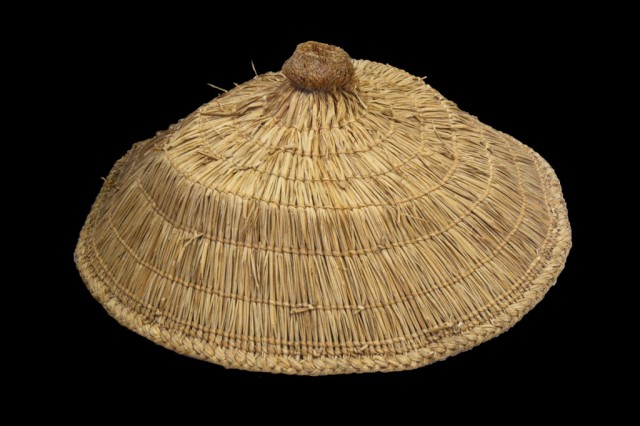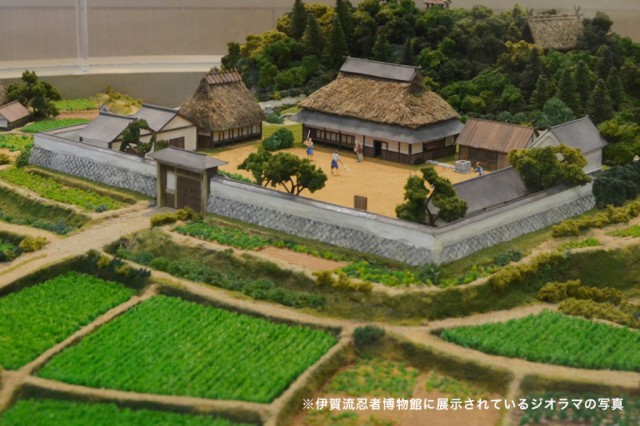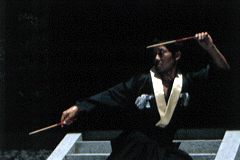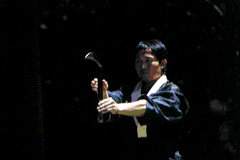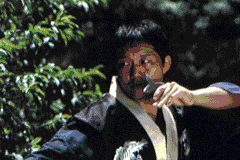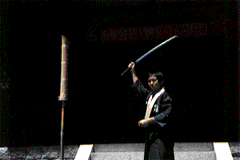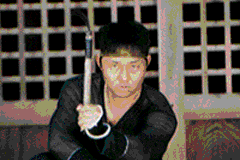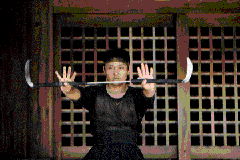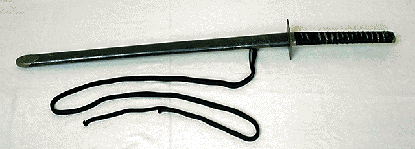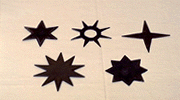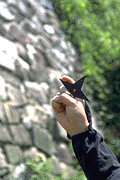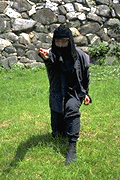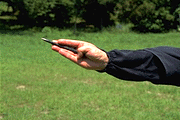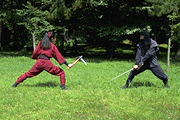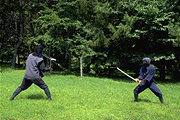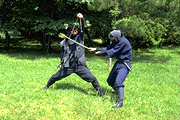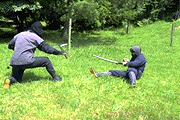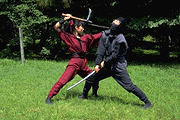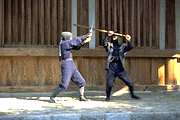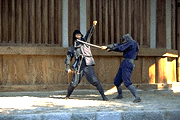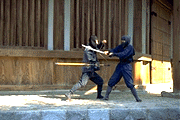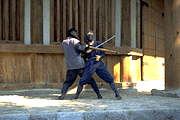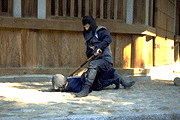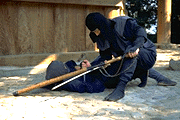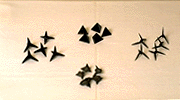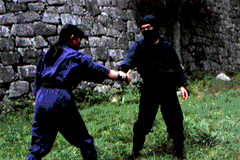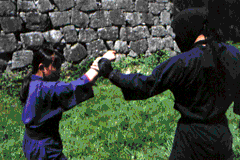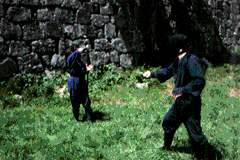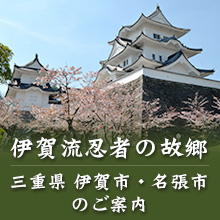The ninja studied the suitable for stalking and human sleep, and selected moonless nights or days when people were fast asleep, which allowed the ninja to achieve his aim by stealth. To know whether the enemy was sleeping sound, the ninja used a pipe as aural aid for the enemy’s snore. For their own sleep, ninjas slept with the heart side down to protect their heart in the event of the enemy’s attack.
Shichihoude (Seven Ninja Disguises)
A ninja could disguise himself in seven different ways: as a straw-hat clad Buddhist priest, traveling priest, a novice priest, merchant, acrobat, street musician, or in everyday attire (farmer or warrior).
Ninja house
There exist a number of ninja house in classic places for the ninja in Japan, needless to say Iga and Koka.
A ninja house looks like a one-story building when viewed from outside, but it consists of three floors. It indeed has a variety of elaborate designs such as hidden rooms, boltholes, and pitfalls.
The ninja blended gunpowder in a hidden room in the house. The tricks were intended to stop enemy intruders whose aim was to spy on gunpowder recipes, which were the top military secret at that time. Accordingly, the ninja house served as a secret gunpowder laboratory as well as the ninja’s residence.
Ninja’s everyday life
Ninja were engaged in farming for camouflagic purposes, as well as for growing medicinal herbs and its own benefits. Their routine work included production of various drugs from herbs and also the important task of making gunpowder for weapons. Another important item was training. They trained bodily strength and improved memory; and slept without making noise with the left side down to guard the heart if someone attacks with a sword. In short, their life was all training!
Chopstick Shuriken
Chopsticks would pierce the enemy’s body when given fast rotation.
*These demonstrations are very dangerous so do not imitate them.
Sickle Shuriken
Throw the sickle against the enemy and make it rotate in the air.
*These demonstrations are very dangerous so do not imitate them.
Shuriken
Pinch the shuriken between the thumb and the forefinger, and throw it as it rotates in the air.
*These demonstrations are very dangerous so do not imitate them.
Handling a sword in one hand
The straw bundles are cut obliquely down in the angle of 45 degrees and cut up in the same angle.
*These demonstrations are very dangerous so do not imitate them.
Cutting the straw bundle in three
The straw bundle is cut obliquely consecutively always in the angle of 45 degrees. When cutting the foot that proceeds forward must be back in the same position.
*These demonstrations are very dangerous so do not imitate them.
The Iga double sickles 1
If it touches the body even just a little, it would cut the body easily. The enemy will be threaten by the fast movements.
*These demonstrations are very dangerous so do not imitate them.
The double sickles 2
If it touches the body even just a little, it would cut the body easily. The enemy will be threaten by the fast movements.
*These demonstrations are very dangerous so do not imitate them.
The Ninja sword
The swords that the Ninjas used were approximately two feet long and less. The swords were rather wide compared to the popular Japanese swords, and thick and straight in form. In addition to pierce the enemies, the swords were used in various ways. The sword itself was sometimes used as a step when climbing high walls, and the case of the swords were used for breathing in water and hearing secret conversations beyond walls.
Shuriken
The Shurikens, made from forged iron with strong points, are the most famous weapon of the Ninjas. As the they were easy to carry around and because they didn’t produce any sound, and also for easy use (especially the flat type that were simply thrown to the enemies without measuring the distance), the Ninjas frequently used the Shurikens. There were four types of Shurikens; a stick type, a flat type, a cross type and a two-layer flat type.
How to throw a Shuriken
Shurikens were thrown in a way to rotate in the air. And when a Shuriken hits an enemy, it was best to be in a vertical position against the enemy’s body.
Also as it was natural for anybody to possess nails, the Ninja sometimes used nails as Shurikens.
Sickles with chains
Sickles with chains 1
This weapon was a sickle with a chain approximately 3 feet long extending from it.
The Ninjas would grab the sickles and rotate the chains in the air. As it was a powerful weapon requiring little force, the woman Ninjas often took use of them.
Sickles with chains 2
One way to use this weapon is to bind the enemy’s body with the chain.
Sickles with Chains 3
This weapon can also be used to bind the enemy’s neck. The Ninja would fling the enemy away by using the chain.
Trick sticks
Ninjas used trick sticks which had a metal piece and chain hidden within. These sticks were used as weapons as well as tools to disguise the Ninjas into old people.
Maki-bishi
The Maki-bishi is a pyramid shaped weapon hat has three sharp points. Among the three points, the one in the top position would damage the feet of the enemies when spread on the ground. The Maki-bishi were made of iron, bamboo, or by twisting two needles. This weapon was usually used when escaping from enemies.
Tekko-kagi
The ninja had weapons and tools of all types and sizes for various uses, including:
Tekko-kagi: Iron claw worn on the back of the hand.
Kunai: Tool for digging in hard soil and making holes in mud walls.
Saku: For picking locks.
Self-defense 1 (right hand grabbing right wrist)
When grabbed by hand from inside.
Taking the point on your right wrist where you were grabbed as your starting point, straighten your right forefinger and rotate your right hand clockwise to grab the attacker’s arm. The pressure of your forefinger against the bone of the attacker’s wrist should cause some pain. Holding the attacker’s wrist between thumb and forefinger, firmly twist his arm up in the direction of rotation, kick the back of his knee from behind, and elbow him in the head when he is bent over. While the attacker is momentarily overcome, run away. When you run away, take as many turnings as possible rather than going down narrow alleys. Ten seconds should be enough to give any pursuers the slip.
*Think of another technique or method of escape if there is a risk of injury.
Self-defense 2 (left hand grabbing right wrist)
When grabbed by hand from outside.
Taking the point on your right wrist where you were grabbed as your starting point, straighten your little finger and rotate outwards to grip the attacker’s arm. The pressure of your little finger against the bone of the attacker’s wrist should cause some pain. Holding the attacker’s wrist between thumb and forefinger, firmly twist his arm up in the direction of rotation, kick the back of his knee from behind, and elbow him in the head when he is bent over. While the attacker is momentarily overcome, run away. Self-defense is effective in an emergency as it surprises an attacker.
*Think of another technique or method of escape if there is a risk of injury.
Self-defense 3 (attacker holding weapon in right hand)
When holding a stick or umbrella, etc.
Grab the stick you are carrying in your left hand with your right hand,quickly change your left hand to an underhand grip, and swing upwards.
At this point, the right hand should be supporting the stick so that it rotates around about the left hip. Helping the stick to rotate will increase the power of the blow. While the attacker is momentarily overcome, run away.
The trick is to keep yourself at just the right distance so that the stick hits the attacker’s weapon or wrist.
Nowadays, an umbrella is just right for this. This technique requires a little practice.
*Think of another technique or method of escape if there is a risk of injury.
